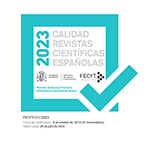Geometría y técnica en dos retablos-tabernáculos fingidos españoles: Ermitas de Nuestra Señora de La Soledad (Puebla de Montalbán, Toledo) y de San Isidro (Alcalá de Henares)
Resumen
Tratamos en este artículo de hacer un análisis geométrico descriptivo y gráfico, así como técnico, de dos obras maestras del retablo fingido español separadas por más de 140 años: el retablo de la ermita de Nuestra Señora de La Soledad de Puebla de Montalbán (Toledo), obra de los hermanos González Velázquez y fechado en 1741; y el retablo de la iglesia de San Isidro de Alcalá de Henares (Madrid), obra de Manuel Laredo y fechado en 1885.
Ambas pinturas tienen en común representar un Tabernáculo, pero también tienen en común la grandiosidad y perfección en su trazado, además de estar realizadas por artistas poco afamados. El retablo-Tabernáculo es una arquitectura que se puede rodear y su representación sobre el muro conlleva un mayor conocimiento de las reglas de la perspectiva para su correcto trazado. Se analiza a su vez la influencia que tuvieron los quadraturistas y tratadistas de geometría en este tipo de representaciones.
Junto a este análisis geométrico consideramos imprescindible adentrarnos en la materialidad de las obras, su estructura y estratificación que, unido al estudio de los métodos de trasposición de los bocetos y las técnicas pictóricas empleadas para las representaciones, nos ayudará a comprender mejor la metodología empleada por los autores en la confección de estas pinturas murales.
Descargas
Descarga artículo
- Pintura mural, capilla mayor de la iglesia de Santa María presso. San Sátiro de Milán. Figura 1B. Tabernáculo, iglesia de San Lorenzo de Florencia.
- Figura 2A. Retablo fingido. Ermita de Nuestra Señora de la Soledad, Puebla de Montalbán (Toledo).Figura 2B. Retablo fingido. Ermita de San Isidro, Alcalá de Henares (Madrid).
- Figura 3A. Cornisa toscana. Fuente: Pozzo Tomo II fig. 32i. Figura 3B. Altar pintado en Frascati.
- Figura 4. Determinación de la perspectiva del Tabernáculo con la que se estructura la pintura mural de la ermita de Nuestra Señora de la Soledad.
- Figura 5. Determinación de la perspectiva del Tabernáculo con la que se estructura la pintura mural de la ermita de San Isidro.
- Figura 6.A. Ermita de Nuestra Señora de la Soledad: detalle de jornada (1), agujero de cartón (2) y dibujo inciso por medio de punzón sobre mortero fresco (3). Figura 6.B. Ermita de Nuestra Señora de la Soledad: detalle del dibujo inciso (1). Figura 6.C.
- Pintura mural, capilla mayor de la iglesia de Santa María presso. San Sátiro de Milán. Figura 1B. Tabernáculo, iglesia de San Lorenzo de Florencia.
- Figura 2A. Retablo fingido. Ermita de Nuestra Señora de la Soledad, Puebla de Montalbán (Toledo).Figura 2B. Retablo fingido. Ermita de San Isidro, Alcalá de Henares (Madrid).
- Figura 3A. Cornisa toscana. Fuente: Pozzo Tomo II fig. 32i. Figura 3B. Altar pintado en Frascati.
- Figura 4. Determinación de la perspectiva del Tabernáculo con la que se estructura la pintura mural de la ermita de Nuestra Señora de la Soledad.
- Figura 5. Determinación de la perspectiva del Tabernáculo con la que se estructura la pintura mural de la ermita de San Isidro.
- Figura 6.A. Ermita de Nuestra Señora de la Soledad: detalle de jornada (1), agujero de cartón (2) y dibujo inciso por medio de punzón sobre mortero fresco (3). Figura 6.B. Ermita de Nuestra Señora de la Soledad: detalle del dibujo inciso (1). Figura 6.C.
Licencia
La revista Arte, Individuo y Sociedad, para fomentar el intercambio global del conocimiento, facilita el acceso sin restricciones a sus contenidos desde el momento de su publicación en la presente edición electrónica, y por eso es una revista de acceso abierto. Los originales publicados en esta revista son propiedad de la Universidad Complutense de Madrid y es obligatorio citar su procedencia en cualquier reproducción total o parcial. Todos los contenidos se distribuyen bajo una licencia de uso y distribución Creative Commons Reconocimiento 4.0 (CC BY 4.0). Esta circunstancia ha de hacerse constar expresamente de esta forma cuando sea necesario. Puede consultar la versión informativa y el texto legal de la licencia.










